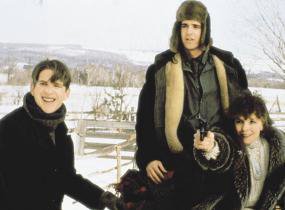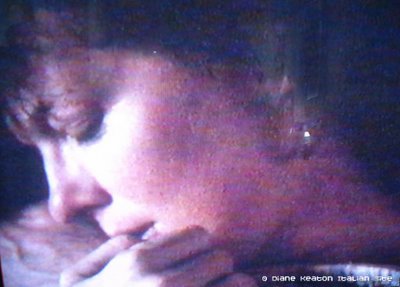Diane Keaton, Mrs. Soffel
Thursday, January 12, 2006
Sunday, April 10, 2005
Pauline Kael
“Mrs. Soffel gets into a great subject: repressed, often well-educated women who fall in love with prisoners--men in cages….
“…. Gillian Armstrong doesn't lay out the reasons for what happens; she evokes them partially, suggestively, inviting you to fell your way into Kate Soffel's disappointment with her marriage. We can see the torment and dissatisfaction in Kate's face, and the neurasthenia that has kept her in bed for three months…. Surrounded by husband, children, and servants, the imprisoned Kate sits in her tightly bound clothes; under the curls on her forehead, her eyes are full of misery…. [T]here's something about her that makes you uneasy; she's telling the prisoners that faith will do something for them that it has obviously failed to do for her.
“What's daring in the way Gillian Armstrong presents this love story is that we don't quite trust the emotions of either Kate Soffel or Ed Biddle. She's sickly, frustrated, unstable; he's an opportunist, with only one opportunity--to make her love him so madly that she'll bring him and Jack the saws they need to get out…. But Kate isn't a fool, and she's twelve years older than Ed; she's aware of how he's trying to use her. At the same time, she's sexually aroused by him--he's like a trapped animal reaching out to her, pulling her up against his cell.
“Mel Gibson … is superb here…. [Ed] puts the squeeze on Mrs. Soffel, and it makes her feel alive; it takes a while before we realize that she does the same for him. Diane Keaton has trouble with the period role: her fast, distraught, manner of speaking, the words she emphasizes, the ones she throws away--it's all very specifically modern. So is her conception of neurosis, and so, I think, is the tender, easy manner Kate has with her children. (Shouldn't she be more erratic, taking out some of her suffering on them, or, at least, be negligent and indifferent?) But she has a moment here that's freakishly inspired: Ed has been holding her against the bars and she has been speaking like a moral exemplar when suddenly, in mid-sentence, she lets out a dirty little giggle. We know then that Kate is living in a fever dream and doesn't want to wake up. And the post-hippie diction and the other surface flaws in Keaton's performance fade into relative insignificance, because the things that come from inside are so startingly right. Kate has a broad, lewd smile when she holds out her Bible to Ed--with the saws in it….
“…. One thing that makes their love story different from the familiar ones is that they finally come clean with each other….
 “…. [T]he movie builds an excitement that has something to do with the fact that the flight of the Biddles with Kate in tow is deranged. They're killing each other by staying together, yet you can see that staying together is all that matters to them. When the three of them are out in the snow, rushing toward the border, the hurrying about makes Kate flush, and her eyes and teeth shine--she seems elated and glamourous. She's experiencing freedom, and the feelings that were buried in her are released. When a stranger says something grossly insensitive in her presence, and she slaps him, all her senses seem to be whirring. She's a Victorian madwoman heroine.”
“…. [T]he movie builds an excitement that has something to do with the fact that the flight of the Biddles with Kate in tow is deranged. They're killing each other by staying together, yet you can see that staying together is all that matters to them. When the three of them are out in the snow, rushing toward the border, the hurrying about makes Kate flush, and her eyes and teeth shine--she seems elated and glamourous. She's experiencing freedom, and the feelings that were buried in her are released. When a stranger says something grossly insensitive in her presence, and she slaps him, all her senses seem to be whirring. She's a Victorian madwoman heroine.”Pauline Kael
The New Yorker, Dec. 24, 1984
State of the Art, pp 290-293
David Edelstein
“Diane Keaton has never seemed more fragile. She begins the film in her sickbed, and you can sense how the plush apartment, the cold jail, and the bilious air are slowly poisoning her--she's thin-skinned, and neither strong nor stupid enough to repress her revulsion for very long. When she reads to prisoners from the Bible, she trances out, laboring in vain to channel her misery into faith. (This is the sort of effort that a movie like Tender Mercies would celebrate instead of explode.) But her face still flushes at the faintest stirring of emotion, and when she and the Biddles finally flee into the crisp, icy countryside, a giddy voluptuousness fairly bubbles out of her. I'd call her Mrs. Soffel the best performance of the year, except that Keaton has already grabbed that slot, in The Little Drummer Girl. This is the next best.”
“…. [LO some on my copy]: ….But it's made with clarity and intelligence and acted with aching bravura….”
David Edelstein
Village Voice, date? 1985
[also left out some from the beginning on Mrs. Soffel's character]
David Denby
“A familiar Victorian parable unfolds: Mrs. Soffel, unhappily married to the warden . . ., covers her misery with good works. Dutifully, she goes among the prisoners, passing Bibles and blankets through the bars--an angel of light trembling in her black dress. . . . Ed . . . sets about seducing Mrs. Soffel--not by charming her but by taunting her faith in God. If God were just, he says, would he allow an innocent man to hang? Sardonic and fiery, and then courtly, even gentle, he catches her imagination, and in a burst of sympathy, she helps the Biddles escape….
“It really happened (in 1901), but the story is still a bit of wheeze: One waits, without much expectation of surprise, for sex to overwhelm piety (there's no movie if it doesn't). But the two stars are magnetic. Her hair in a bun, Diane Keaton has an almost Hepburn-like quality this time--taut, hypersensitive, with a touch of primness in the set of the long, elegant jaw, yet yielding and deeply romantic. A few perverse moments raise the performance to the level of brilliance. At one moment, nestling inside her high black collar, she glares at her husband with unaccustomed disdain, and she looks startlingly wicked; this American Victorian housewife could be Anna Karenina preparing to betray Karenin. When she brings Mel Gibson a couple of narrow saws, and he reaches through the bars and under her skirts, removing the instruments from her boots, she laughs delightedly, with the voluptuous pleasure of a child eating forbidden goodies--the first sign of real happiness….
“The two star performances might have caused a sensation if Gillian Armstrong had let them expand a bit…. [Armstrong] creates a little prison of her own--the austere compositions, the silence, the discretion of a directorial style that places a higher premium on discipline and consistency than expression…. [E]ven after the Biddles and Mrs. Soffel have escaped, the movie remains forbiddingly dark…. [A]ll this severity works against the film's meanings. Mrs. Soffel, in the arms of her lover, is happy and free. Why can't a little color come into her life? Mrs. Soffel never breaks loose--it's a muted, bewilderingly constrained and monotonous film. Despite all the talent at work in it, one still has to fight off the enfolding arms of sleep.”
David Denby
New York, January 14, 1985
David Ansen
“The sickly, Bible-quoting Mrs. Soffel (Diane Keaton) scandalized proper Pennsylvanians in 1901….
“…. As an objet d'art, [the movie] is pretty impressive. As a love story, however, it is not everything one wants it to be.
“But how close Diane Keaton brings it to true passion. Outside her husband's pious home, a wild flush enters her skin and her eyes gleams as she revels in her illicit adventure. Mel Gibson gets to show more range than he ever has . . . . Armstrong's unusual film is too studied for its own good, but at its best much too good to be ignored.”
David Ansen
Newsweek, January 14, 1985
David Thomson
“Mrs. Soffel . . . was a great improvement [for Keaton after The Little Drummer Girl]: her own sense of mischief helped bring the prison governor's wife into erotic flowering, and she seemed to impress Mel Gibson.”
David Thomson
A Biographical Dictionary of Film,
Third Edition (1994), p. 391
James Wolcott
“…. [W]hen the action in Mrs. Soffel shifts north…, the movie takes on a tonic, wintry sting--your eyelids begin to flicker in the cold. But what's more distinctive and thrilling about Mrs. Soffel is its feminist sinew. Unlike the young heroines of Armstrong's earlier films, Mrs. Soffel doesn't seem fit for rebellion. Gowned in black, clasping a Bible, Keaton's Kate Soffel is slow to melt into flushed life; she's a pale candle of bourgeois piety. Once the waxy coating slides from Keaton's features, however, she gives the sort of purifying, damn-all performance whe gave in Shoot the Moon. For Mrs. Soffel is ultimately a movie about a woman who chooses damnation, who hurls her soul into the abyss and faces her ate with renegade composure. It has been said that the first great moment in American literature was when Huck Finn, refusing to betray the slave Jim, said, "All right, then, I'll go to hell." Huck's soul in its violent flight, in its own passionate loyalties, refused to kneel before God and society, and so it is with Mrs. Soffel. Or as Emerson put it, "The soul becomes… [shoving] Jesus and Judas equally aside." In Mrs. Soffel, Jesus and Judas scatter like geese before her heretical love.
“Mrs. Soffel is also the movie in which Mel Gibson, a sex-symbol star, defines himself as an actor…. His scenes with Keaton near the end seem shorn of all art and protection; they have a plunging-into-icy-waters shock and invigoration.
“As passionately responsive as Gibson and Keaton are to each other in Mrs. Soffel, the movie truly belongs to Gillian Armstrong….”
James Wolcott
Texas Monthly, February 1985
Sunday, March 27, 2005
Rigor
"Diane Keaton gives a remarkably complex and nuanced performance. The film is almost unimaginable with[out] her in the leading role. Early in the film she communicates the torment and longing of Kate in a way that warrants comparisons with the greatest acting of the silent cinema. We see the depression and desperation in Kate's face in a way that rivals Maria Falconetti in Dryer's THE PASSION OF JOAN OF ARC and Lilian Gish in Victor Sjöström's THE WIND and D.W. Griffith's BROKEN BLOSSOM'S. One of the remarkably subversive aspects of the film is its relationship to Kate's Christianity (which becomes particularly pointed watched in the contemporary context and thinking about Mel Gibson's PASSION OF THE Christ fundamentalism). She is a bit scary creeping about the prison trying to sell doomed men on a faith that will set them free. The suggestion is that it is this same faith, or more precisely the way Christianity is used as a structuring device of patriarchy, that has trapped Kate into her own life sentence. When she becomes aroused by Ed everything shifts, she looks different, some kind of remarkable radiance shines forth from Keaton's face. Her bible lessons become a pretext for sexual release. She literally makes love to Ed through the bars with his brother nearby, which adds a remarkable charge of voyeurism to the proceedings."
Rigor (Craig Harshaw), IMDb, January 25, 2005
(Intersetions posting: October 27, 2005.)

